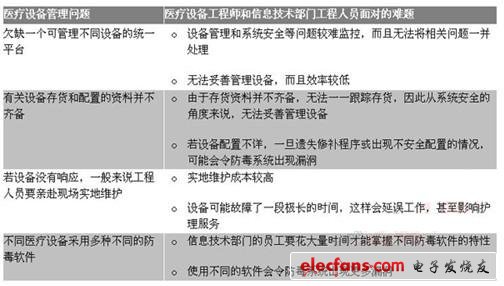How can connected hospitals manage and protect their medical equipment through the same platform?
As long as medical institutions digitize the file system for recording medical records and integrate different medical and diagnostic systems, they can reduce the operating cost of the system, reduce redundancy, ease the work pressure of administrative staff, and reduce the occurrence of medical accidents. Can improve the level of medical services. Such a connected hospital is currently only a concept, but it is also a dream we hope to achieve. Once this plan is implemented, the hospital can integrate daily management, health monitoring and patient care, scanning and diagnosis, and medical record management systems through the network. However, as the equipment required by hospitals is increasing and the circuit design is becoming more complex, it is not easy to manage these devices, provide protection for them, and ensure that they can be interconnected. According to the current development, there will only be more and more hackers who take risks on the Internet. They are not necessarily criminal gangs that are rich in money. Many people only make a name for themselves because they are obscured by nothing. As the number of hackers using advanced technology to illegally attack the Internet has soared, the risk of cyber attacks has also increased. In addition, in order to ensure the safety of the medical system, various local governments have promulgated new information system security laws and personal data protection laws, and strengthened law enforcement in this regard. Once the criminals are convicted, the punishment is quite severe. Intel, Symantec, and Emerson Network Power have worked together to develop the concept of "connected hospitals" because of this development. "Connected hospital" is not just a theoretical concept, but a practical solution. Its advantage is that it can provide a unified management platform for the computing system of medical institutions to support advanced remote management functions and enhanced systems. Security. The core of this feasible solution is the Metro * medDISPENSE * Automated MedicaTIon Dispensing System, which features the MITX-CORE-820 platform using Emerson Network Power. This article mainly introduces the new technologies used in this feasible solution, and discusses in detail how the hospital's information technology department should make full use of these new technologies to improve the management efficiency of medical equipment and more effectively ensure the safety of medical records. Connected Hospital Connected hospitals store all medical records electronically, which is the cornerstone of connected hospitals to provide excellent services. Thanks to this electronic medical record (EMR) system, medical staff can easily share information. All the data of the connected hospital are stored in a huge database, without a piece of drawing paper. The advantage of electronic medical records is that it can improve the service level of medical staff, so that patients can enjoy better medical services, and the health of patients is also guaranteed. Figure 1 shows a conceptual diagram of "connected hospitals". Taking the hospital in the figure as an example, medical staff can quickly obtain medical records of related patients through the hospital's network system. The security of the entire system is very tight, and medical staff do not have to worry about data leakage when sharing relevant information. Connecting hospitals can simplify the entire diagnosis process and allow patients to get better care, and the hospital's network system can improve the efficiency of doctors, nurses and administrative staff, and help improve medical services. Taking medical staff as an example, if they have urgent needs, they can obtain patient medical records through the hospital network anytime, anywhere. In addition, hospital administrators can flexibly deploy manpower and simplify work processes through the system in order to improve work efficiency, reduce errors in the dispensing process, and reduce operating costs. Potential problems with information technology As digital information technology becomes more sophisticated, the confidentiality of data and the management of different devices have become issues of great concern. The primary task of the hospital's information technology department is to establish an architecture platform that can be used together, linking many different software and hardware. The relevant software and hardware systems include data storage systems, wired and wireless communication systems, and anti-virus systems with multiple confidential designs. And a device management system that supports configuration and loading of patches and updated software. Every device connected to the hospital network must have a strict anti-virus device to ensure that the software and hardware will not be invaded by viruses and hackers. But the problem is that different devices have different software platforms. It is very difficult to establish a unified platform architecture to manage different devices and ensure system security. As hospitals continue to purchase new equipment, staff in the paramedical and information technology departments face increasing work every day. Related tasks include managing inventory, configuring systems, loading patches, performing protective functions, and providing warranty and maintenance services. Table 1 lists the problems faced by medical equipment engineers and information technology engineers and the impact these problems have on the daily operation of the hospital. Table 1: Problems faced by employees in the hospital's information technology department Fargo Cleaning Card,Fargo Printer Cleaning Card,Fargo 82133 Cleaning Cards,Fargo Cleaning Kit Miraclean Technology Co., Ltd. , https://www.mrccleanroom.com
Figure 1: Conceptual diagram of "Connected Hospital" 